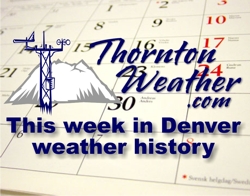
This may be the first full week of spring officially but as any longtime Colorado resident will tell you, spring-like weather is not a given this time of year. As we look back at this week in Denver weather history, it is very clear that oftentimes Old Man Winter insists on hanging around for a bit longer.
18-21
In 1907…a warm spell resulted in 6 daily temperature records. Record maximum temperatures of 82 degrees occurred on the 18th with 81 degrees on the 19th and 80 degrees on the 20th. Record high minimum temperatures of 52 degrees occurred on the 19th and 20th with 54 degrees on the 21st.
19-21
In 1888…heavy snowfall totaled 8.6 inches over downtown Denver. North winds were sustained to 27 mph on the 19th.
20-21
In 1878…warm days with high temperatures in the lower 70’s in the city…caused snow to melt on the palmer divide…which caused the waters in Cherry Creek to rise. The high…rapid running water damaged a home and eroded bridge footings and abutments. Some bridges became unsafe for the passage of trains.
In 1904…southwest winds sustained to 48 mph with gusts to 60 mph warmed the temperature to a high of 68 degrees on the 20th. The high was only 42 degrees on the 21st behind a cold front…which produced 1.3 inches of snow and northeast winds sustained to 27 mph overnight.
In 1923…post-frontal rain changed to heavy snow and totaled 8.2 inches over the city. North winds were sustained to 27 mph with gusts to 29 mph on the 20th. This was the second major snow in a week.
In 1932…rain changed to heavy snow…which totaled 6.2 inches in downtown Denver. North winds gusted to 22 mph on the 21st.
In 1948…heavy snowfall totaled 7.2 inches over downtown Denver.
In 1952…a major snow storm produced north wind gusts to 35 mph and dumped 16.9 inches of snowfall on Stapleton Airport. The maximum snow depth on the ground was 13 inches due to melting.
In 2000…heavy snow fell in and near the foothills of Douglas and Jefferson counties. Snowfall totals included: 9 inches near tiny town and 7 inches in Littleton. Snowfall totaled only 1.8 inches at the site of the former Stapleton International Airport. North winds gusted to 34 mph at Denver International Airport on the 20th.
20-22
In 1944…heavy snow fell over metro Denver for a total of 36 hours. The storm dumped 18.5 inches of snowfall over downtown Denver and 12.2 inches at Stapleton Airport. Fortunately…there were no strong winds with the storm. North winds to only 19 mph were recorded on the 21st.
21
In 1898…an apparent Canadian cold front produced strong winds and plunged temperatures from a high of 56 degrees to a low of 8 degrees late in the day. North winds were sustained to 48 mph with gusts to 60 mph.
In 1908…light snowfall of 1.3 inches produced 0.10 inch of precipitation. This…along with the 0.01 inch of precipitation on the 8th…resulted in the driest March on record with a total of 0.11 inch of precipitation.
In 1916…southwest winds were sustained to 46 mph with a gust to 48 mph. The Chinook winds warmed the temperature to a high of 62 degrees.
In 1923…heavy snowfall totaled 8.0 inches in downtown Denver.
In 1953…northwest winds gusting to 57 mph briefly reduced visibility to 3/4 miles in blowing dust at Stapleton Airport.
In 1981…rain changed rapidly to snow…but totaled only 2.8 inches at Stapleton International Airport. North winds gusting to 35 mph produced much blowing snow and reduced the visibility to a half mile at times. Over the higher elevations of south metro Denver…4 to 6 inches of snow were measured.
Continue reading March 21 to March 27 – This week in Denver weather history


